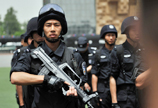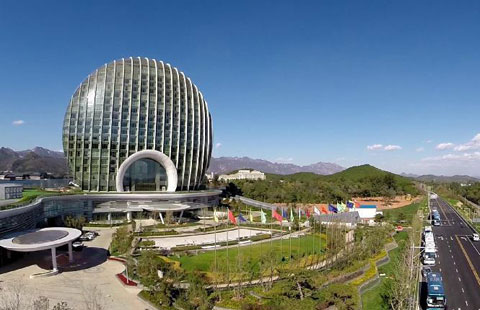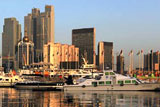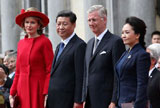Hallmarks of APEC Beijing meetings A-Z
Updated: 2014-11-12 18:20
(Xinhua)
|
||||||||||
BEIJING - The Asia-Pacific Economic Cooperation (APEC) meetings, which concluded Tuesday, are set to engrave a number of hallmarks in the history of APEC, the host country China and the Asia-Pacific as a whole.
Xinhua compiled a list of 26 key words that highlight the fruits borne by the historic meetings.
A
Anti-corruption declaration
APEC members have decided to adopt the Beijing Declaration on Fighting Corruption and set up a cross-border law enforcement network to strengthen transnational anti-corruption cooperation. They committed to working together against rampant corruption and deny safe haven for corrupt officials and their illicit assets in this region.
B
Blue
"APEC blue" is a popular phrase coined by China's netizens to describe the blue sky in the heavily-polluted Beijing during the APEC week, which was a result of tough emission-reduction measures. The Chinese people hope to make APEC blue a "new normal".
C
Connectivity
APEC leaders approved the "APEC Connectivity Blueprint 2015-2025" to lay the foundation for all-round connectivity in the Asia-Pacific region, involving the construction of new roads, railways and shipping lanes; the slashing of regulatory constraints; and the easing of barriers to people-to-people interaction and mobility.
D
Dream
After advocating the China Dream, Chinese President Xi Jinping called for the fulfillment of the Asia-Pacific Dream of common development, prosperity and progress.
E
E-commerce
E-commerce and the Internet economy, a new engine for economic growth, was included in the APEC meetings' agenda for the first time. It's potential was on full display throughout China's Singles' Day, which coincided with the closure of the meeting on Nov. 11, when the online buying fiesta smashed records, with e-commerce giant Alibaba ringing-up sales of over 45 billion yuan (7.3 billion U.S. dollars) thanks to the world's biggest online retail sales day.
F
Fresh mission
APEC leaders have defined the fresh mission for the bloc in the aftermath of the global financial crisis, which is to smash a variety of "shackles" to embrace a new round of grand openness, communication and integration.
G
Global value chains (GVCs)
APEC leaders adopted a strategic blueprint for promoting GVC development and cooperation. This will help to better understand and support the "trading tasks" involved in adding value to cross-border final products, and contribute to the realization of a more effective policy and regulatory infrastructure for global trade.
H
Host
This is the second time China has played host to APEC leaders in 13 years. Since the 2001 Shanghai meeting, extraordinary changes have taken place in China, now the world's second largest economy compared to the sixth back then. The meeting is set to reshape APEC and the world.
I
Information Technology Agreement (ITA)
During the APEC meetings, the United States announced that it reached a consensus with China on resuming and finalizing negotiations on updating the World Trade Organization's ITA by including more products. It was confirmed by the Chinese Ministry of Commerce. The expansion of ITA has a significant commercial value, as consensus had been made upon the tariff exemption on about 200 items, involving about 2.77 trillion U.S. dollars of global trade. If an agreement is reached, it will become the first agreement on tariff cuts since the establishment of the WTO.
J
Japan
China-Japan relations saw signs of ice-breaking improvement during the APEC meetings. A four-point principled agreement to improve bilateral ties was reached, leading to the meeting between Chinese President Xi Jinping and Japanese Prime Minister Shinzo Abe in Beijing. Where will China-Japan relations go? The world is watching.
K
Korea
During the APEC meetings, leaders of China and the Republic of Korea (ROK) announced that the two countries had concluded substantive negotiations on a bilateral free trade agreement (FTA). President Xi Jinping said the FTA was "of landmark importance," while President Park Geun-hye said, "it is a day worth celebrating for both ROK and China."
L
Landmark
The APEC Beijing meetings will be remembered as a landmark in the history of APEC and China. It is one of the largest and most fruitful meetings for APEC economies, while it is the most important and significant diplomatic event held by China in recent years.
M
Maritime
The APEC Beijing meetings served as a platform for maritime issues. Among the four-point principled agreement reached between China and Japan was the acknowledgement of their "different positions on the Diaoyu Islands." Chinese and Vietnamese leaders pledged to handle maritime issues through dialogue and consultation. Leaders of China and the Philippines held a short conversation, in which disputes in the South China Sea was discussed.
The development of maritime economy was also high on the APEC meetings' agenda.
N
New normal
In his speech at the APEC CEO Summit, Chinese President Xi Jinping, for the first time, sketched out a full picture of the Chinese economy's "new norm", which was characterized by "medium-to-high speed growth", "constantly improved and upgraded economic structure" and "increasingly driven by innovation instead of input and investment."
O
Opportunities
In the wake of the global financial crisis, the APEC leaders have pinned down five areas for future growth, including economic reform, new economy, innovative growth, inclusive support and urbanization.
P
Partnership
Partnership was the APEC buzzword.
"Shaping the Future Through Asia-Pacific Partnership" was the most comfortable common ground all APEC members could agree on. In a region home to the world's top three economies and other traditional powers, partnership acquired a new definition: "Those who share the same ideal and follow the same path can be partners. Those who seek common ground while shelving differences can also be partners."
Q
Quarter of century
Twenty-five years ago, APEC was born in Canberra in the dying light of the Cold War. Under its auspices, the Asia-Pacific region has evolved from a geographic concept into a global economic engine that accounts for 40 percent of the world's population, 57 percent of GDP, and 48 percent of trade value. The APEC Beijing meetings are set to herald a new era for APEC and Asia-Pacific.
R
Reform
Reform was on the agenda of the APEC Beijing meetings. All APEC economies, most of which are faced with growth bottlenecks, agreed that reform was a key tool to resort to in securing a successful post-global crisis era.
APEC itself also needs reform to improve.
S
Silk Road Fund
China will contribute 40 billion U.S. dollars to set up a Silk Road Fund.The money will be used to provide investment and financing support for infrastructure, resources, industrial and financial cooperation, and other projects related to connectivity for Asian countries.
T
Trade Roadmap
The Free Trade Area of the Asia-Pacific (FTAAP) process was officially launched during the APEC Beijing meetings, as the leaders approved the Beijing Roadmap for APEC's Contribution to the Realization of the FTAAP.
The FTAAP does not go against existing arrangements, such as TPP and RCEP, which are potential pathways to realize the FTAAP goal.
U
United States
After being absent from APEC Economic Leaders' Meeting for two years in a row, U.S. President Obama attended the Beijing meetings before paying a state visit to China. During the meeting with Obama, President Xi urged both sides to push forward a new type of major-country relationship. Obama told Xi that the U.S. has no intention of containing China because it was not in its own interests.
V
Visa extension
Under a new arrangement, China and the U.S. will issue multi-entry business and tourist visas with the validity to up to 10 years, and multi-entry student and exchange visas with the validity of up to 5 years to each other's citizens.
W
Wisdom
A great era calls for a great vision, which in turn requires great wisdom. At the APEC Beijing meetings, "China wisdom" was highlighted in many ways. China was the top contributor to setting the agenda for the meetings, with more than half of the over 100 initiatives drafted by China.
Xi
Xi Jinping
Chinese President Xi Jinping, who attended and chaired many events during the APEC meetings, won the most attention from global media. His book titled "Xi Jinping: The Governance of China," which was displayed at the entrance to the media center, was a hot book. Hundreds of copies -- in multiple languages including Chinese, English, French, Russian, Arabic, Spanish, Japanese and German -- were taken away by journalists everyday. The book is a record of speeches and instructions by Xi from Nov. 15, 2012 to June 13, 2014.
Y
Yanqi Lake
This was where the APEC Economic Leaders' Meeting was held. Yanqi Lake, at the foot of the Yan Mountain 50 kilometers north of downtown Beijing, means "the lake of swan geese".
Citing an ancient Chinese poem, President Xi said the 21 APEC members were just like 21 swan geese, meeting at the lake to enhance cooperation and embark on a new flight to shape a new vision for the development of the Asia-Pacific region.
Z
Zhong
"Zhong" means "China" literally. The specially-designed outfits worn by APEC leaders and their wives at a grand banquet hosted by President Xi are "new Zhong-style" garments. In elegant colors from purple, green, crimson to brown, the suits and dresses were made of silk and adorned with elements representing China's rich history and traditions.









